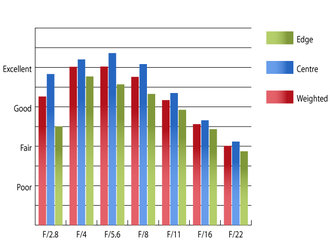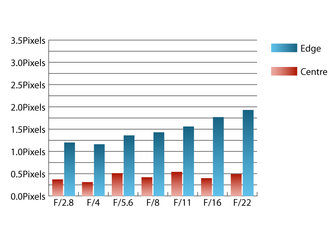Olympus M.Zuiko Digital 17mm f/2.8 Pancake Lens Review
Olympus M.ZUIKO DIGITAL 17mm f/2.8 Performance
As it typical for pancake optics, sharpness in the centre of the frame is high at maximum aperture, approaching excellent levels, but the clarity towards the edges of the frame isn't quite as good, only achieving fairly good levels of sharpness. MTF at 17mm | How to read our chartsThe blue column represents readings from the centre of the picture frame at the various apertures and the green is from the edges. Averaging them out gives the red weighted column.The scale on the left side is an indication of actual image resolution. The taller the column, the better the lens performance. Simple. For this review, the lens was tested on an Olympus PEN E-P2 using Imatest. |
Stopping down improves clarity across the frame, with peak performance being achieved between f/4.and f/5.6, where sharpness in the centre is excellent, and very good towards the edges of the frame.
 CA at 17mm | How to read our chartsChromatic aberration is the lens' inability to focus on the sensor or film all colours of visible light at the same point. Severe chromatic aberration gives a noticeable fringing or a halo effect around sharp edges within the picture. It can be cured in software.Apochromatic lenses have special lens elements (aspheric, extra-low dispersion etc) to minimize the problem, hence they usually cost more. For this review, the lens was tested on an Olympus PEN E-P2 using Imatest. |
Levels of chromatic aberrations are on the high side, exceeding one pixel width at every aperture and increasing as the lens is stopped down. This level of fringing may pose issues, especially with image containing high contrast towards thee edges of the frame.
Falloff of illumination towards the corners of the frame can be noticeable at maximum aperture. Here the corners are 1.5 stops darker than the image centre and visually uniform illumination is achieved with the lens stopped down to f/5.6 or beyond.
Very strong barrel distortion for a lens of this type is present, which may pose issues when shooting any subjects with straight lines, such as architecture. Imatest detected 4.96% barrel distortion, which is incredibly high for a lens of this type. Many Micro Four Thirds cameras correct this automatically, but the correction process will result in a reduction in resolution towards the edges of the frame.
This lens can suffer with a noticeable loss of contrast when shooting scenes containing a bright light source. Saying that, flare is rarely an issue, even with the sun towards the edge of the frame.
Add your message
Login required
Please login here or if you've not registered, you can register here. Registering is safe, quick and free.
Please login here or if you've not registered, you can register here. Registering is safe, quick and free.
photodo Stats
1102 lenses
428 MTF tests
74 in-depth photodo reviews
100+ users join each day
Help the lens community by reviewing or rating a lens today via our lens search
428 MTF tests
74 in-depth photodo reviews
100+ users join each day
Help the lens community by reviewing or rating a lens today via our lens search
Latest Lens Reviews
- Chinon 28mm f/2.8 Vintage Lens Review
- Canon EF 70-200mm f/4L IS II USM Lens Review
- Samyang AF 85mm f/1.4 EF Review
- Sigma 70mm f/2.8 DG Macro Art Review
- Samyang AF 24mm f/2.8 FE Review
- Meike 50mm f/1.7 Review
- Tamron 70-210mm f/4 Di VC USD Review
- Lensbaby Burnside 35mm f/2.8 Review
- Asahi Super Takumar 50mm f/1.4 Review
- Asahi Super-Multi-Coated Takumar 135mm f/3.5 Review
